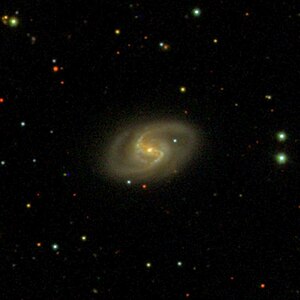NGC 2512
| Galaxie NGC 2512 | |
|---|---|
 | |
| SDSS-Aufnahme | |
| AladinLite | |
| Sternbild | Krebs |
| Position Äquinoktium: J2000.0, Epoche: J2000.0 | |
| Rektaszension | 08h 03m 07,8s[1] |
| Deklination | +23° 23′ 31″[1] |
| Erscheinungsbild | |
| Morphologischer Typ | SBb / Sbrst[1] |
| Helligkeit (visuell) | 13,1 mag[2] |
| Helligkeit (B-Band) | 13,9 mag[2] |
| Winkelausdehnung | 1,4′ × 0,9′[2] |
| Positionswinkel | 113°[2] |
| Flächenhelligkeit | 13,2 mag/arcmin²[2] |
| Physikalische Daten | |
| Zugehörigkeit | LDCE 547[1] |
| Rotverschiebung | 0.015684 ± 0.000020[1] |
| Radialgeschwindigkeit | (4702 ± 6) km/s[1] |
| Hubbledistanz H0 = 73 km/(s • Mpc) | (207 ± 14) · 106 Lj (63,4 ± 4,4) Mpc [1] |
| Durchmesser | 85.000 Lj[3] |
| Geschichte | |
| Entdeckung | William Herschel |
| Entdeckungsdatum | 10. Februar 1787 |
| Katalogbezeichnungen | |
| NGC 2512 • UGC 4191 • PGC 22596 • CGCG 118-052 • MCG +04-19-021 • IRAS 08001+2331 • 2MASX J08030785+2323308 • GC 1614 • H III 605 • h 482 • NVSS J080307+232331 • 2MIG 1075 | |
NGC 2512 ist eine Balken-Spiralgalaxie mit hoher Sternentstehungsrate vom Hubble-Typ SBb im Sternbild Krebs auf der Ekliptik. Sie ist schätzungsweise 207 Millionen Lichtjahre von der Milchstraße entfernt und hat einen Durchmesser von etwa 85.000 Lichtjahren.
Das Objekt wurde am 10. Februar 1787 von Wilhelm Herschel entdeckt.[4]
Weblinks
Einzelnachweise
Auf dieser Seite verwendete Medien
Autor/Urheber: Sloan Digital Sky Survey, Lizenz: CC BY 4.0

Angle of view: 4' × 4' (0.3" per pixel), north is up.
Details on the image processing pipeline: https://www.sdss.org/dr14/imaging/jpg-images-on-skyserver/